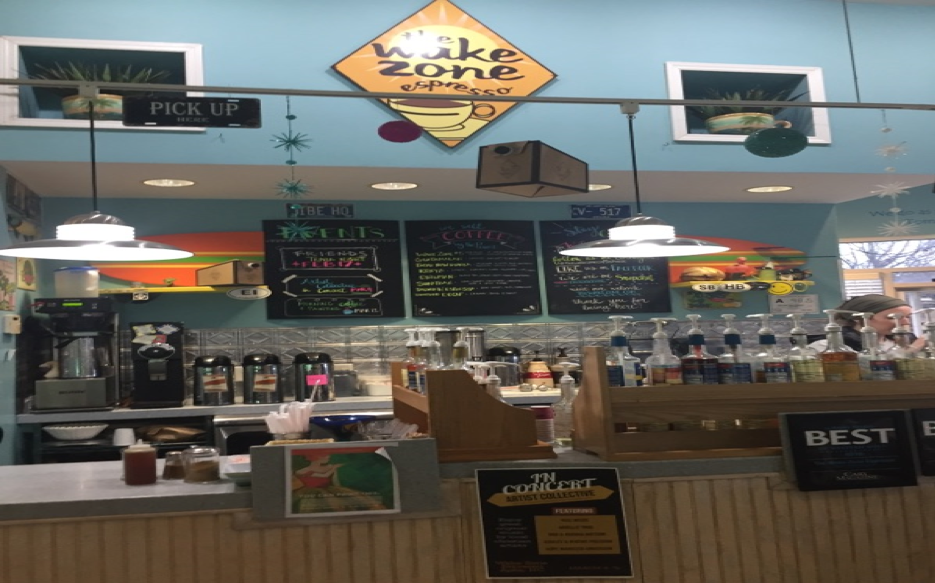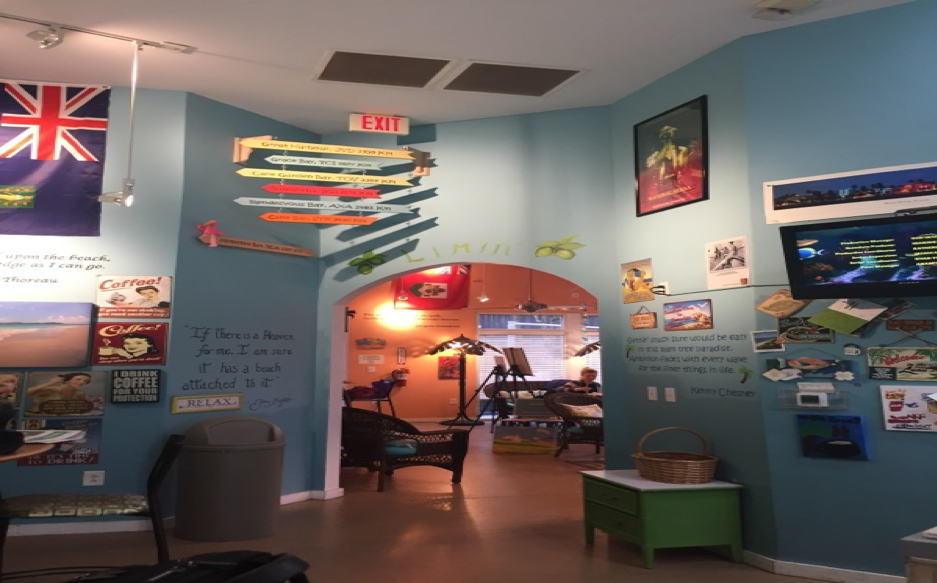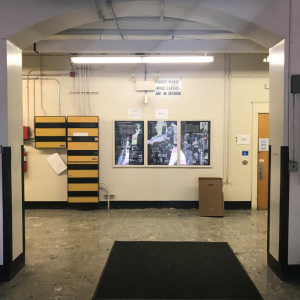
By Allison Miszewski
Chances are that one wouldn’t notice Wake Zone Coffee House without actually looking for it. Within one of the smallest plazas in Apex, N.C., Wake Zone is nestled alongside a gas station, a nail salon and two permanently closed restaurants. If you know about it, it’s likely because someone has told you about it.
Or it’s because you’re low on fuel and have swerved down the plaza’s steep entrance to fill up the tank. Perhaps the two aquamarine beach chairs gracing its entrance at the end of the shopping strip have caught your eye.
Brightly colored posters alert that there are warm mochas inside, the perfect remedy for an abnormally chilly afternoon. As you walk in, a smiling barista greets you.
A taste of paradise
The loud buzzing of espresso machines competes cheerfully with Bob Marley’s “Three Little Birds” playing on the speakers. A warm breeze wafts from the large ceiling fan that resembles the spinning motor of a boat. An eclectic collection of quotes and objects adorns the turquoise walls. Among the décor are ocean sunset paintings by local artists, a large Cuban flag, a string of baseball hats from places like Bass Pro Shops and Atlantic Beach, and a painted scroll of Jimmy Buffett lyrics.
The lamps resemble swaying palm trees.
You must be by the sea.
Paul Peterson, the owner of this tiny getaway, rushes from the drive-thru window to the front register with three iced hot chocolates in his hands. Despite the crowded environment, he remains collected in his jeans, leather sandals and Bob Ross t-shirt that endorses the painting of “happy, little trees.”
“It’s always nice when people say that they like your coffee,” Peterson said. “But lots of people can make coffee that tastes good. However, not a lot of people can make someone feel comfortable, not every place can make someone feel special. We want to be that third place, in between home and work, that makes people feel welcomed and like they can be themselves.”
Peterson is not an island native, far from it. After completing a bachelor’s degree at Illinois State University, he went on to earn a master’s degree in urban planning at the University of Louisville. After living in Maryland for a decade, he worked in Washington D.C. for a division of the where he managed construction programs. Only three years ago did he move to North Carolina as director of facilities for the Kenan-Flager Business School at UNC-Chapel Hill.
Peterson ultimately wanted a more “chill” occupation that was a closer commute from his family’s home in Apex. So, on Oct. 1, 2017, he purchased Wake Zone from its original owners.
“I always enjoyed the vibe and theme of the place, and I felt like it matched my personality,” Peterson said. “It was coffee without pretention. Here, our customers get to have fun with it.”
He also added that there would be no “looking down upon” people who like to make specialty drinks; flavor creativity would be welcomed at Wake Zone.

Coffee connecting community
Harriet Scott, a girl with a tie-dye bandana pulling her curly brown hair away from her face, places a blended mocha with a marshmallow shot onto the seashell-covered counter. Her cheeks are sprinkled with freckles and her persona radiates sunshine.
Originally, Scott didn’t see herself working at a coffee shop after graduating from a small, Catholic college in Rhode Island with a bachelor’s degree in religious studies.
“Ministry doesn’t always pay the big bills,” Scott said. “So, I looked for a job that had similar values, one of them being building community.”
Wake Zone, with its dedication to making customers like family, was the perfect fit. Her favorite moment working as a barista so far has been when one customer became a close friend through “divine intervention.”
“This girl randomly came up to me, saying that she had been coming in everyday and that God put it on her heart to make a connection with me,” Scott said.
Such connections seem to develop often at Wake Zone. Maybe this is a byproduct of the café’s intentional engagement with the local community. It sells homemade products, ranging from jewelry to knitted hats to keychains, crafted by artisans all across the Triangle.
“The idea was to make the ‘craft stand’ a focal point for the community,” Peterson said. “It is about giving small vendors, crafters and college kids trying to work their way through school an opportunity to make money doing what they love.”

Local and loved
Rose and Dave Weitzel, known as The Laser People, have been supplying customized tumblers for Wake Zone since August 2017. Residents of Cary, North Carolina for 25 years, they acquired a laser cutter for their home from China. Why? In the beginning, they planned just to create birthday and anniversary gifts for people they knew, but soon their hobby evolved into a real business.
“By word of mouth, we started being asked to make things for people outside of the family,” said Rose Weitzel. “We can engrave or etch on just about everything. We have done cutting boards, signs, glasses, pocket knives — the list is endless!”
The best product that the husband-wife team got asked to create was a marriage proposal on a tumbler. They loved being able to be a part of that special moment, they said.
“Our customers are very involved in the design process, which makes the final product even more meaningful,” said Rose Weitzel.
The staff at Wake Zone and the artisans they support clearly seem to believe that customers are more than what the contents of their wallets can purchase.
The secret syrup
A caffeinated beverage, paired with a staff that knows customers by name, seems to have brewed a tranquil, poetic atmosphere.
Looking around, one can’t help but notice the pleasant, wide variety of visitors Wake Zone attracts. Two older gentlemen with long, white beards are discussing the news. There’s a group of high school students clicking away in unison on their sticker-covered laptops. There’s also young couple laughing nervously on what seems to be their first date.
“As soon as you walk in, it feels like you’re in Wilmington,” said Natalie Hoffman, a loyal customer and social work major at the Franciscan University of Steubenville. “Meeting friends there is like going to the beach, if it were feasible by a cup of great coffee and only five minutes down the street.”
After taking a last sip of mocha, you pack up your things to head back into the frigid sleet. You feel warmer than expected. Maybe it was the tropical atmosphere. Maybe it was the genuine kindness shown by the employees.
Regardless, you’ll never want to simply pass by this hidden gem from paradise ever again.
Edited by MaryRachel Bulkeley








